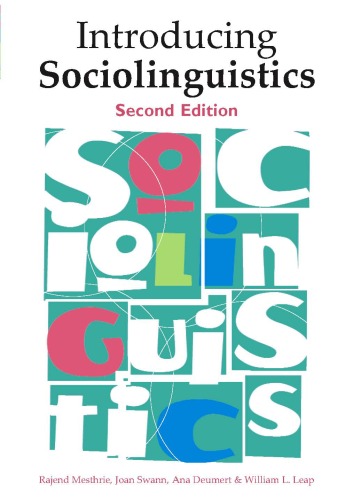Introducing Sociolinguistics 2nd Edition by Rajend Mesthrie, Joan Swann, Ana Deumert ISBN 9789027232656 by Rajend Mesthrie, Joan Swann, Ana Deumert, William L. Leap 9780748638437, 9780748638444, 0748638431, 074863844X instant download after payment.
Introducing Sociolinguistics 2nd Edition by Rajend Mesthrie, Joan Swann, Ana Deumert - Ebook PDF Instant Download/Delivery: 9789027232656
Full download Introducing Sociolinguistics 2nd Edition after payment

Product details:
ISBN 13: 9789027232656
Author: Rajend Mesthrie, Joan Swann, Ana Deumert
Sociolinguistics is one of the central branches of modern linguistics and deals with the place of language in human societies. This second edition of Introducing Sociolinguistics expertly synthesises the main approaches to the subject. The book covers areas such as multilingualism, code-choice, language variation, dialectology, interactional studies, gender, language contact, language and inequality, and language and power. At the same time it provides an integrated perspective on these themes by examining sociological theories of human interaction. In this regard power and inequality are particularly significant. The book also contains two chapters on the applications of sociolinguistics (in education and in language policy and planning) and a concluding chapter on the sociolinguistics of sign language. New topics covered include speaking style and stylisation, while current debates in areas like creolisation, globalisation and language death, language planning, and gender are reflected
Introducing Sociolinguistics 2ndTable of contents:
Part I: Foundations and Core Concepts
Chapter 1: What is Sociolinguistics?
- Defining Sociolinguistics: Language in its Social Context
- The Scope of Sociolinguistics: What Do Sociolinguists Study?
- Key Questions and Goals of Sociolinguistic Inquiry
- Brief History of the Field
- How Sociolinguistics Differs from Linguistics and Sociology
Chapter 2: Language Variation and Varieties
- The Concept of Variation: Why Language is Not Uniform
- Types of Variation: Regional, Social, Stylistic, Idiolectal
- Dialects and Accents: Distinguishing Between Them
- Standard Language and Non-Standard Varieties
- Isoglosses and Dialect Continua
- Speech Communities and Communities of Practice
Chapter 3: Language and Identity
- How Language Shapes and Reflects Identity
- Social Identity: Age, Gender, Ethnicity, Social Class
- Personal Identity and Language Use
- In-group and Out-group Markers
- Code-Switching and Identity Performance
Part II: Social Factors and Linguistic Variation
Chapter 4: Social Class and Language
- Defining Social Class in Sociolinguistics
- Early Studies: Labov and Martha's Vineyard, New York City
- Markers of Social Class in Language (Phonological, Lexical, Grammatical)
- Status, Prestige, and Social Networks
- Social Mobility and Linguistic Change
Chapter 5: Gender and Language
- Historical Perspectives on Language and Gender
- Differences in Language Use: Phonological, Lexical, Conversational Style
- Dominance vs. Difference Approaches
- Gendered Speech Communities and Performativity
- Language and Sexuality
Chapter 6: Ethnicity and Language
- Ethnolects and Ethnic Varieties of Language
- African American Vernacular English (AAVE) as a Case Study
- Language Maintenance and Shift in Minority Communities
- Code-Switching for Ethnic Identity and Solidarity
- Language and Multiculturalism
Chapter 7: Age and Language
- Age-Grading in Language Use
- Generational Differences in Speech
- Language Change in Progress: The Role of Young People
- Language and the Elderly
Part III: Language in Social Interaction
Chapter 8: Speech Acts and Conversational Implicature
- Austin and Searle: Locutionary, Illocutionary, and Perlocutionary Acts
- Grice's Maxims of Conversation (Quantity, Quality, Relation, Manner)
- Violations and Flouting of Maxims
- Politeness Theory: Face and Politeness Strategies (Brown & Levinson)
Chapter 9: Conversation Analysis
- Turn-Taking Mechanisms and Adjacency Pairs
- Openings and Closings of Conversations
- Repairs and Backchannels
- Overlap and Interruption
- Analyzing Real-Time Spoken Interaction
Chapter 10: Narrative and Discourse
- Different Types of Narrative in Everyday Life
- Structure of Personal Narratives
- Discourse Analysis: Beyond the Sentence Level
- Critical Discourse Analysis (CDA): Language and Power
Part IV: Language in Society and Institutions
Chapter 11: Language and Power
- Language as a Tool of Social Control
- Power Dynamics in Institutional Settings (e.g., legal, medical, educational)
- Asymmetric Communication
- Language and Ideology
Chapter 12: Language Planning and Policy
- Definitions: Status Planning, Corpus Planning, Acquisition Planning
- Official Languages, National Languages, and Working Languages
- Language Revitalization and Language Endangerment
- Language in Education Policies
- Case Studies of Language Policy (e.g., Quebec, India, post-colonial nations)
Chapter 13: Multilingualism and Code-Switching
- Individual vs. Societal Multilingualism
- Types of Code-Switching (Situational, Metaphorical)
- Reasons for Code-Switching: Social, Conversational, Identity-Related
- Diglossia and Multiglossia
- Language Attrition and Language Shift
Chapter 14: Language and Globalization
- The Spread of English as a Lingua Franca
- Hybridity and New Varieties of English
- Language Contact and Language Change
- The Impact of Digital Communication on Language Use
- Linguistic Diversity in a Globalized World
Part V: Research Methods in Sociolinguistics
Chapter 15: Doing Sociolinguistics: Research Methods
- Data Collection Methods:
- Observation (Participant and Non-Participant)
- Interviews (Structured, Semi-Structured, Unstructured)
- Surveys and Questionnaires
- Recordings (Audio and Video)
- Ethnographic Approaches
- Data Analysis Techniques:
- Quantitative Analysis (Statistical Methods)
- Qualitative Analysis (Thematic Analysis, Discourse Analysis)
- Ethical Considerations in Sociolinguistic Research
People also search for Introducing Sociolinguistics 2nd:
introducing sociolinguistics
meyerhoff introducing sociolinguistics
meyerhoff introducing sociolinguistics pdf
meyerhoff miriam 2006 introducing sociolinguistics
meyerhoff m 2006 introducing sociolinguistics
Tags: Rajend Mesthrie, Joan Swann, Ana Deumert, Introducing, Sociolinguistics



